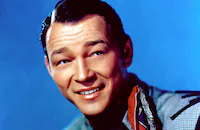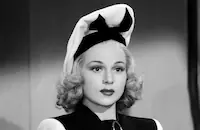Under Western Stars

Brief Synopsis
Cast & Crew
Joe Kane
Roy Rogers
Smiley Burnette
Carol Hughes
Maple City Four
Guy Usher
Film Details
Technical Specs

Synopsis
A lengthy drought plagues the people of the West, creating a "dust bowl," which is catastrophic for farmers and cattlemen alike. When some ranchers in Sage County illegally attempt to open the valve at a damn to get water for their dying cattle, Roy Rogers and his pal Frog help them. Although the sheriff arrests Roy, when they arrive back in town, Roy is hailed as a hero. The townspeople want him to run for Congress, like his late father, but the water company backs the ineffectual incumbent, William P. Scully. John D. Fairbanks, the head of the water company, comes West to speak with Roy, but they fail to reach an understanding. Later, as Roy prepares his first political speech, he is overhead by Eleanor, Fairbanks' daughter, who does not reveal her identity, but tells him she hopes he wins the election. Roy is successful, and promises that when he goes to Washington he will obtain federal assistance to help Sage County. Before he leaves, Eleanor sends him an anonymous note suggesting that he solicit the aid of powerful Congressman Edward H. Marlowe for his proposed water bill. Roy is unable to meet Marlowe until Eleanor sends him another secret note suggesting that he attend a fox hunt at the Marlowe estate. Upon his arrival, he saves Eleanor from a runaway horse and tells her he knows that she is the anonymous note sender. She then suggests that he throw a party and invite some powerful politicians. At the party, which is an old-fashioned square dance, Roy gets the attention of his guests by showing a film that illustrates the desperate plight of his home county. The audience is so moved by the film that several politicians offer their support. Back in Sage County, after Fairbanks learns that the film was actually newsreel footage taken in another state, he tells Marlowe, who thinks that he has been used by Roy. Roy admits that Fairbanks is correct, but says that the facts of the film are just as true for his own state, and concocts a plan to prove it. While Marlowe, Fairbanks and others are driving outside of town, they are ambushed and left only with horses to ride. Attempting to return to town, they become more and more thirsty, and are unable to obtain water from anyone. After camping out all night, they awaken to discover what real thirst is, only to encounter the additional problem of a dust storm. They take shelter at a local ranch during the storm, and the following morning, when Roy arrives, Marlowe realizes that he was responsible for the "ambush." He also realizes that the conditions Roy is trying to correct are real. When Mayor Briggs rides to the ranch to tell Roy that some of the townspeople are about to blow up the dam, Marlowe warns that their action will destroy any chance of Roy's bill passing. To prevent this, Roy rides toward the dam and is able to divert the wagon loaded with dynamite from hitting it. Thus, Roy helps to ensure that life will improve for Sage County.

Director
Joe Kane
Cast

Roy Rogers

Smiley Burnette

Carol Hughes
Maple City Four
Guy Usher
Tom Chatterton
Kenneth Harlan
Alden Chase
Brandon Beach
Earl Dwire
Jean Fowler
Dora Clement
Dick Elliott
Burr Carruth

Charles Whitaker
Jack Rockwell
Frankie Marvin
Earl Hodgins
Trigger
Crew
Gene Autry
Betty Burbridge
Eddie Cherkose
Alberto Colombo
Harry Knight
Jack Lawrence
Jack Marta
Johnny Marvin
Dorrell Mcgowan
Dorrell Mcgowan
Stuart Mcgowan
Stuart Mcgowan
Lester Orlebeck
Charles Rosoff
Sol C. Siegel
Arthur Siteman
Peter Tinturin
Al Wilson

Videos
Movie Clip




Hosted Intro
Film Details
Technical Specs

Award Nominations
Best Song
Articles
Under Western Stars -
Joseph Kane, a director on staff for Republic Pictures, took the chair for the new leading man's first film. Kane had handled a number of Gene Autry Westerns, including the aptly named Tumbling Tumbleweeds (1935), Guns and Guitars (1936) and Ride, Ranger Ride (1936), which are just a few of his 100 plus credits as director. Smiley Burnette, a repeat supporting actor alongside Autry throughout the 1930s, joined Rogers in his first picture. The two would go on to costar in a number of films before the popular supporting actor left Republic in 1944, only to star in more roles as the musical, happy-go-lucky sidekick.
Under Western Stars (1938) was a standout in the B-movie western stock. First, it was more political than the typical genre entry. Where its predecessors dealt in conflicts with Native Americans, the lawlessness of the land and missions of vengeance, Republic's new film was a deeply topical look at environmentalism, governmental policy and the pursuit of truth. Sure, it contains the trademark sequences of cowboys on horseback and last-minute rescues. But it also confronted serious issues, such as the effect of drought on farming communities and water ownership policy.
Songs peppered throughout and performed by Rogers and company broke up the film's whip-crack pace. "Dust," nominated for an Academy Award for Best Original Song, lamented a land exhausted by drought and spoke to the frailty of human existence. The Dust Bowl was still a fresh and painful memory for Americans living in the West, and the song struck a chord.
More Capra than Ford in essence, the plot finds Rogers saving a town from drying up and then making a run for Congress. His aim is to show the plight of his people and to free up water for the improvement of his hometown. Realizing he needs more than proof to convince the politicians, he stages a tactic to make the them understand the pain of thirst firsthand.
Roy Rogers was a made man after the film. He starred in a handful of films in which he played other characters, but it was his strength playing "Roy Rogers" that launched him into a stardom that surpassed Autry at the box office, gave birth to a career in television and splashed his image across a million lunch boxes. He would strum, sing and stride across the screen throughout the 1940s and '50s, riding through the West on his trusty horse, Trigger.
But it all started with this picture, a testament to the hardships and wonders of living under western stars.
By Thomas Davant

Under Western Stars -
Quotes
Trivia
This was 'Rogers, Roy' ' first starring vehicle for Republic Pictures, and it made him an instant hit, billed ever after as "King of the Cowboys".
Notes
The film's pre-production title was Washington Cowboy. A Hollywood Reporter production chart lists Charles E. Ford as the film's producer, but all other sources list only Sol C. Siegel as associate producer. According to contemporary sources, this film was originally to have starred Gene Autry, but when Autry went on strike against Republic Pictures in December 1937, Roy Rogers was named as his replacement. According to a news item in Hollywood Reporter on February 24, 1938, the songs "Listen to the Rhythm of the Range" and "Dust" were purchased by Republic from the composers, Autry and Johnny Marvin, for use in this picture, which was not yet in production. A subsequent news item in Hollywood Reporter on April 13, 1938, just prior to the film's release, noted that Autry was suing the studio for $25,000 for unauthorized use and dramatization of the lyrics to "Dust." The song, which is sung by Rogers during his character's screening of a film about the effects of a drought, is not listed in the onscreen credits, nor are Autry or Marvin listed. In Film Daily Year Book, only Marvin is credited with "Dust" and "Listen to the Rhythm of the Range." The latter song was not included in the released film. According to modern sources, the suit over "Dust" was settled out of court prior to Autry's return to work at Republic in May 1938. For additional information on the Autry-Republic dispute, see Notes on entries for The Old Barn Dance and Gold Mine in the Sky. This was Rogers' first starring film. Reviews were positive about his career potential. Film Daily said that Rogers "should prove a hit," Variety predicted that he "lives up to every expectation and then some....End of year will find Rogers firmly embedded in draw firmament," and Box Office called Rogers a "new crooning son of the saddle...to travel far and fast toward the top among the action favorites." Aside from Autry and John Wayne, Rogers was the only "Western" star to be included in Variety's annual list of the top ten box office stars. According to modern sources, portions of the film were shot on location in Lone Pina, CA and actors Tex Cooper, Curley Dresden, Bill Wolfe, Jack Ingram, Jack Kirk and Fred Burns were in the cast. "Dust" was nominated for an Academy Award.

Miscellaneous Notes
Released in United States 1938
Released in United States 1938














